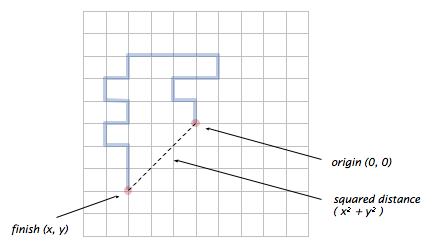1. Conditionals & Loops
Download Project Zip
| Submit to TigerFile
Goals
- To deepen your understanding of conditionals and loops.
- To learn how to debug code.
Background
This assignment is based on the concepts and techniques described in Section 1.3 of the textbook (and the corresponding lectures and precepts). You may also find it instructive to work through some of the other exercises and look at the solutions on the booksite afterwards.
Getting Started
- Download and expand the zip file, which will create the folder
loops. We recommend this folder be placed in acos126folder. - Open the
loopsfolder (i.e., the project) in IntelliJ. - Implement these programs:
SayMilitaryTime.javaRandomWalkers.javaDuotone.javaMusicalDiceGame.java
- Recall: To create a new Java class files, use LIFT → New → Java Class.
- Complete a
readme.txt.
Requirements
- You may not call library functions except those in
java.langsuch asInteger.parseInt()andMath.random(),StdAudioandStdPicture.
- You may not use Java features that have not yet been introduced in the course (such as arrays or functions).
Say Military Time
Military time is a notation for specifying time of day using the form hhmm, where hh denotes the number of full hours that have passed since midnight and mm denotes the number of full minutes that have passed since the last full hour. For example, 1200 is noon; 2359 is one minute before midnight; and 0100 is one hour after midnight.
To speak and read military time, use the following conventions:
- Say the number of hours
hh; if it is between 1 and 9, precede it with the word zero. - Say the word hundred.
- Say the number of minutes
mm(unless it is 00). - Say the word hours.
For example, 2359 is spoken as twenty-three hundred fifty-nine hours and 0100 is spoken as zero one hundred hours.
Write a program SayMilitaryTime.java to say a given military time using these conventions. Your program must take two command-line arguments:
-
Time. The first command-line argument is an integer that represents the time using military notation, such as 1200, 2359, or 0100.
-
Voice. The second command-line argument is a string representing the voice for speaking the time. The subdirectories
Alex,Amélie,Luca,Paulina,Samantha,Veena, andSiricontain voice recordings of people saying the numbers 0 through 59, along with the words for hundred and hours. For example,Alex/59.wavis Alex saying the number 59 andSiri/hundred.wavis Siri saying the word hundred.
Below are some sample executions:
> java-introcs SayMilitaryTime 2359 Alex
> java-introcs SayMilitaryTime 1100 Siri
> java-introcs SayMilitaryTime 0609 Veena
> java-introcs SayMilitaryTime 0011 Paulina
You can access the StdAudio library here.
Background: The 24-hour clock is used widely in Asia, Europe, Africa, and Latin America. In the United States, it is used in the military, aviation, navigation, tourism, meteorology, astronomy, computing, logistics, and hospitals.
Random Walkers
This exercise will give you experience identifying compile-time, run-time and logic errors in Java code.
The project folder contains a program called RandomWalkers.java that takes two integer command-line arguments: the first argument is \(n\) and the second argument is \(trials\). In each of \(trials\) independent experiments, the program is supposed to simulate a random walk of \(n\) steps and compute the squared distance for each trial. The program then outputs the mean squared distance (the average of the trials’ squared distances).
Each random walk starts at the origin \((0, 0)\). At each time step, the walker moves one meter in a random direction, either north, east, south, or west, with probability 25%. The random walk finishes at some postion \((x, y)\). The squared distance for each trial is computed using the formula: \(x^2 + y^2\).

Here are sample executions of the corrected RandomWalkers, with the expected output.
> java-introcs RandomWalkers 100 10000
mean squared distance = 101.446
> java-introcs RandomWalkers 100 10000
mean squared distance = 99.1674
> java-introcs RandomWalkers 200 1000
mean squared distance = 195.75
> java-introcs RandomWalkers 200 1000
mean squared distance = 198.21
> java-introcs RandomWalkers 1600 100000
mean squared distance = 1600.13064
> java-introcs RandomWalkers 1600 100000
mean squared distance = 1603.72
Fix all errors in the provided file RandomWalkers.java. Your solution should have no errors or warnings, including from Checkstyle.
Background: This process is a discrete version of a natural phenomenon known as Brownian motion. It serves as a scientific model for an astonishing range of physical processes, from the dispersion of ink flowing in water, to the formation of polymer chains in chemistry, to cascades of neurons firing in the brain.
Duotone Filter
A duotone filter involves using two colors to create a new image. In particular, a duotone filter is a way to reproduce an image, using combinations of only two ink colors, \(color_1\) and \(color_2\). It is a popular effect for photographers and digital artists. (Here’s a nice site for experimentation.)
To apply a duotone filter to an image, consider each pixel of a source image one at a time:
-
Let \((r, g, b)\) denote the red, green, and blue components, respectively, of the pixel. Each component is an integer between \(0\) and \(255\).
-
Let \((r_1, g_1, b_1)\) and \((r_2, g_2, b_2)\) denote the red, green, and blue components of \(color_1\) and \(color_2\), respectively.
-
Change the color of the pixel from \((r, g, b)\) to \((r^\prime, g^\prime, b^\prime)\) by applying the following formulas:
- First, compute the monochrome luminance of the given color as an intensity between \(0.0\) and \(255.0\) using the NTSC formula:
- \(luminance = (0.299r + 0.587g + 0.114b) / 255.0 \)
- Then, compute \(r^\prime, g^\prime, b^\prime\) using the formulas:
- \(r^\prime = luminance \times r_1 + (1 - luminance) \times r_2\)
- \(g^\prime = luminance \times g_1 + (1 - luminance) \times g_2\)
- \(b^\prime = luminance \times b_1 + (1 - luminance) \times b_2\)
- When computing \(r^\prime, g^\prime, b^\prime\, round the results to the nearest integer, so that \(r^\prime\), \(g^\prime\), and \(b^\prime\) are integers between \(0\) and \(255\).
- First, compute the monochrome luminance of the given color as an intensity between \(0.0\) and \(255.0\) using the NTSC formula:
Write a program Duotone.java that takes the name of an image file as a command-line argument, along with the values for \(r_1, g_1, b_1, r_2, g_2, b_2\), and applies a duotone filter to that image, and displays the results in a window. Use StdPicture to read, modify, and display the picture.
For example, given a photo of Johnson Arch:

executing the command:
java-introcs Duotone JohnsonArch.jpg 245 128 37 0 0 0
produces the image:

In this sample execution, \(color_1\) is Princeton orange (245, 128, 37) and \(color_2\) is black (0, 0, 0).
Also, take a photo of a building, archway, gate, or other structure on campus and apply the duotone filter to that image. Submit a JPEG file named MyPhoto.jpg of the source (original) image, and include the values you used to generate the duotone version of MyPhoto.jpg in your readme.txt.
You can access the StdPicture library here.
FAQ: Q. How do I round a
double xto the nearest integer? A.(int) Math.round(x).
Musical Dice Game
A Musikalisches Würfelspiel is a process for generating music randomly by concatenating a sequence of precomposed musical elements. In this exercise, you will compose a Viennese waltz in the style of Mozart by playing a sequence of 32 precomposed measures that are chosen according to the random process described below. The waltz has two parts — the minuet, followed by the trio.
- The minuet consists of a sequence of 16 measures (numbered 0 to 15), each chosen at random. To determine which WAV file to play for measure \(i\), roll two fair dice. If the sum is \(s\), then play
minueti-s.wav. For example, if you roll an 8 for the measure 3, then playminuet3-8.wav. Note that each roll has 11 possible outcomes (2 through 12) but some outcomes (such as 7) are more likely than others (such as 2 or 12).

- The trio consists of a sequence of 16 measures (numbered 0 to 15), each chosen at random. To determine which WAV file to play for measure \(i\), roll one fair die. If the result is \(s\), then play
trioi-s.wav. For example, if you roll a 6 for the measure 15, then playtrio15-6.wav.

The mozart-piano subdirectory of the project file contains the 272 WAV files (11 × 16 = 176 for the minuet measures and 6 × 16 = 96 for the trio measures), using the naming conventions described above. Other subdirectories (mozart-clarinet, mozart-flute-harp, and mozart-mbira) correspond to different musical instruments.
Write a program MusicalDiceGame.java that plays a waltz according to the rules above. Your program should take one string as a command-line argument. That string specifies the name of a subdirectory containing the WAV files, such as mozart-piano. Here are some sample executions:
> java-introcs MusicalDiceGame mozart-piano
> java-introcs MusicalDiceGame mozart-piano
> java-introcs MusicalDiceGame mozart-clarinet
> java-introcs MusicalDiceGame mozart-flute-harp
> java-introcs MusicalDiceGame mozart-mbira
Context: each time you run the program you will compose a piece of music that has never been heard before! The precomposed measures obey a rigid harmonic structure so that each waltz reflects Mozart’s distinct style. However, due to this rigid structure, the process never results in anything truly extraordinary.
Submission
Submit the files Military.java, RandomWalkers.java, Duotone.java, MyPhoto.jpg and MusicalDiceGame.java, along with completed readme.txt and acknowledgments.txt files to TigerFile
.
Grading
| Files | Points |
|---|---|
| RandomWalkers.java | 9 |
| SayMilitaryTime.java | 9 |
| Duotone.java | 9 |
| MusicalDiceGame.java | 9 |
| readme.txt | 4 |
| Total | 40 |
This assignment was developed by Kevin Wayne. Copyright © 2022–2024.